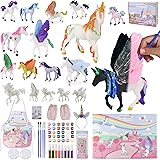"10 watercolor painting techniques for beginners and experts"
In this post, we explore ten different watercolor painting techniques, from the most basic to the most advanced. It includes visual examples, tips for avoiding common mistakes, and how to combine techniques to create amazing effects on your artwork. You can also mention the necessary materials and recommendations of brands and products.
Introduction:
Watercolor painting is a unique and versatile artistic technique that allows you to create vibrant and beautiful works of art. For those looking to learn or hone their watercolor skills, here are 10 essential techniques that can be applied at both beginner and expert level. In addition, we'll include a list of necessary materials and brand and product recommendations to ensure you have what you need to start your creative journey.
- Flat washing: This basic technique consists of applying a uniform color over a large area of paper. To accomplish this, use a wide, wet bristle brush loaded with paint diluted in water.
- Gradient wash: It is a variation of flat washing in which the color gradually fades. Apply more water and less pigment as you scroll through the paper, creating a smooth gradient effect.
- Wet-on-wet: This technique involves applying paint to a previously moistened surface, allowing colors to blend and blur naturally. To achieve this, moisten the paper with a clean brush before applying the paint.
- Wet-on-dry: Unlike the previous technique, this technique involves applying wet paint on dry paper, which allows for more defined edges and greater control over the mixing of colors.
- Glazing: It consists of applying thin, transparent layers of paint on previously painted and dry areas, allowing the colors to blend visually without physically mixing on the paper. This helps create depth and luminosity effects.
- Sgraffito: This technique involves scraping or scratching the wet surface of the paint to reveal the underlying color or white of the paper. You can use a sharp object, such as a toothpick or the tip of a brush, to create fine details and textures.
- Splashes: This technique creates a random, abstract texture effect by splashing water droplets or paint on paper. You can use a brush, a toothbrush or even your fingers to achieve different effects.
- Printing: Watercolor printing involves applying paint on objects such as sponges, bubble wrap, or any other textured surface and then pressing them onto the paper. This creates unique patterns and textures in your artwork.
- Reserves: This technique involves protecting certain areas of the paper to keep them paintless. You can use duct tape, masking liquid, or even wax to create reserve areas that will later be revealed when the protective material is removed.
- Hair dryer drying: Speeds up the drying process using a hair dryer at low power and at a safe distance from the paper. This allows you to work on additional layers of paint without waiting too long.
Necessary materials and recommendations of brands and products:
- Watercolor paper (continued): Opt for good quality watercolor paper, such as Arches, Canson, or Strathmore, for best results. Look for fine-grained, medium or coarse grain papers, depending on your preferences and the technique you want to use.
- Brushes: Invest in quality watercolor brushes that retain water and pigment properly. Recommended brands include Winsor & Newton, Da Vinci and Escoda. Make sure you have a variety of shapes and sizes, such as round, flat, and detail brushes.
- Watercolor paints: Watercolor paints come in tube or pickup formats. High-quality brands such as Winsor & Newton, Daniel Smith and Schmincke offer intense and long-lasting pigments. Make sure you have a basic color palette to get started.
- Palette: A plastic or ceramic mix palette is essential to match and dilute your watercolor colors. Ceramic palettes, such as those of Mijello or John Pike, are highly recommended.
- Water and containers: You will need water containers to clean your brushes and dilute your paints. It is advisable to have at least two containers, one to rinse the brushes and another to obtain clean water. You can also use an atomizer to moisten the paper or reactivate the colors.
- Masking fluid and duct tape: Masking fluid, such as Winsor & Newton or Schmincke, allows you to cover areas of paper that you want to keep unpainted. Adhesive tape is useful for creating straight, clean edges on your works, as well as for attaching paper to the drawing board.
- Drawing board or stand (continued): A drawing board or stand made of wood, plastic or even cardboard is useful for keeping the paper stretched and preventing it from deforming when working with watercolors. Look for drawing boards with clips to hold the paper securely, such as those from Art Alternatives or Alvin.
- Paper towels or absorbent cloths: Having paper towels or absorbent cloths on hand is essential for drying your brushes, correcting mistakes, or removing excess water from your watercolors. You can use kitchen towels or microfiber cloths.
- Pencil and eraser: A medium hardness (HB) pencil and soft eraser are ideal for drawing previous sketches before applying watercolors. Plastic erasers or moldable rubbers are recommended options, as they do not damage watercolor paper.
conclusion:
Mastering watercolor painting techniques takes practice and patience, but with these 10 techniques and the use of quality materials, both beginners and experts can improve their skills and create unique and vibrant works of art. Don't be afraid to experiment with different techniques and colors, and remember that practice makes perfect. Good luck on your creative journey and enjoy the wonderful experience that watercolor painting offers!













